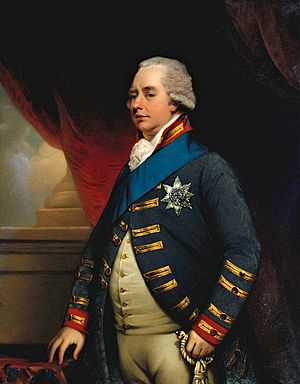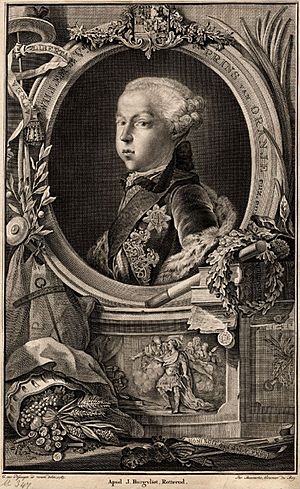William V, Prince of Orange facts for kids
Quick facts for kids William V |
|||||
|---|---|---|---|---|---|

Portrait by Henry Bone (1801)
|
|||||
| Prince of Orange | |||||
| Period | 22 October 1751 – 9 April 1806 | ||||
| Predecessor | William IV | ||||
| Successor | William VI | ||||
| Prince of Orange-Nassau | |||||
| Reign | 22 October 1751 – 9 April 1806 | ||||
| Predecessor | William IV | ||||
| Successor | William VI | ||||
| Stadtholder of the United Provinces | |||||
| Reign | 22 October 1751 – 23 February 1795 | ||||
| Predecessor | William IV | ||||
| Successor | Stadtholdership abolished | ||||
| Born | 8 March 1748 The Hague, Dutch Republic |
||||
| Died | 9 April 1806 (aged 58) Brunswick, Brunswick-Lüneburg |
||||
| Spouse |
Princess Wilhelmina of Prussia
(m. 1767) |
||||
| Issue | Louise, Hereditary Princess of Brunswick-Wolfenbüttel William I of the Netherlands Prince Frederick |
||||
|
|||||
| House | Orange-Nassau | ||||
| Father | William IV, Prince of Orange | ||||
| Mother | Anne, Princess Royal | ||||
| Religion | Dutch Reformed Church | ||||
William V (born Willem Batavus on 8 March 1748 – died 9 April 1806) was an important figure in Dutch history. He was the prince of Orange and the very last stadtholder of the Dutch Republic. A stadtholder was like a chief executive or head of state in the Dutch Republic.
William V had to leave his country and go into exile in London in 1795. He also ruled the Principality of Orange-Nassau until he passed away in 1806. His son, William, took over this role after him.
Contents
Growing Up: William V's Early Life
William Batavus was born in The Hague, a city in the Dutch Republic, on 8 March 1748. He was the only son of William IV. His father had just become stadtholder again the year before William V was born.
Sadly, William V was only three years old when his father died in 1751. This meant that others had to rule for him until he was old enough. This period of ruling for a young leader is called a regency.
Who Helped William V Rule?
Several people acted as regents for William V:
- His mother, Dowager Princess Anne, ruled from 1751 until she died in 1759.
- His grandmother, Dowager Princess Marie Louise, took over from 1759 until her death in 1765.
- Duke Louis Ernest of Brunswick-Lüneburg also helped from 1759 to 1766. He stayed on as a special advisor until 1784.
- His sister, Princess Carolina, helped from 1765 until William became an adult in 1766. She was 22 years old when she became a regent.
In 1752, William was honored by becoming a Knight of the Order of the Garter. This is a very old and important award in Britain.
Becoming Stadtholder: William V's Rule Begins
William V officially became the stadtholder and Captain-General of the Dutch States Army in 1766. This happened when he turned 18, which was considered adulthood at the time. However, he still let the Duke of Brunswick have a lot of power in the government.
William V's Marriage and Interests
On 4 October 1767, Prince William married Princess Wilhelmina of Prussia in Berlin. She was the daughter of Augustus William of Prussia and the niece of Frederick the Great. She was also a cousin of King George III of Great Britain. William himself was King George III's first cousin.
William V was very interested in art. In 1774, he opened his own art gallery, called the Galerij Prins Willem V, for the public to enjoy.
Challenges During His Rule
During the American Revolutionary War, the Dutch Republic tried to stay neutral. William V wanted to support the British. However, other groups in the government wanted to help the American and French sides.
Things became difficult when the Dutch tried to join a group called the First League of Armed Neutrality. This led to the Fourth Anglo-Dutch War in 1780. The Dutch were not ready for war, and they lost some important places like St. Eustatius and Nagapattinam.
People started to lose trust in William V's government. There were even rumors of treason. This made many people want political changes. A famous pamphlet called Aan het Volk van Nederland (To the People of the Netherlands) was published in 1781, calling for reforms.
The Patriot Movement and Conflict
After a peace treaty was signed in 1783, more and more people in the Dutch Republic were unhappy with William's leadership. A group called the Patriots challenged his power. This group included both old leaders and people who wanted more democracy.
In 1785, William left The Hague and moved his court to Het Loo Palace in Gelderland. This was a province far from the main political center. In 1786, he sent his army to stop the Patriots in the cities of Hattem and Elburg. Because of this, the Patriot-controlled government in Holland took away his title as Captain-General of the Army.
In 1787, William's wife, Wilhelmina, tried to go to The Hague to start an uprising to support William. But she was stopped by Patriot groups and forced to return to Nijmegen.
This event angered Wilhelmina and her brother, Frederick William II of Prussia. Frederick decided to send the Prussian army into Holland in September 1787 to stop the Patriots. Many Patriots then fled to France, where they were supported by King Louis XVI of France.
Life in Exile: William V Leaves the Netherlands
William V joined a group of countries called the First Coalition against France in 1793. This was after the French Revolution began. His troops fought bravely, but by 1794, the situation was getting worse, and French armies were threatening the Dutch Republic.
The year 1795 was a very bad one for the old Dutch government. French armies, along with Dutch revolutionaries who had returned from Paris, took over the Netherlands. In 1795, William V had to leave his country and go into exile in England. Just a few days later, the Batavian Revolution happened, and the Dutch Republic was replaced by the Batavian Republic.
The Kew Letters and Colonies
Soon after arriving in England, William V wrote several letters from his new home in Kew. These are known as the Kew Letters. In these letters, he told the leaders of the Dutch colonies around the world to hand over their colonies to the British. He said this was necessary as long as France controlled the Netherlands.
Not all colonies followed his orders, but many did. Most Dutch colonies were eventually taken by the British. Later, some of these colonies were returned, but not all of them. For example, South Africa and Ceylon remained British.
Attempts to Return to Power
In 1799, William's son, the Hereditary Prince, tried to help in the Anglo-Russian invasion of Holland. He helped capture a Dutch naval fleet in the Vlieter Incident. The ships were formally given to William V as stadtholder, and he was later allowed to sell them to the British Royal Navy.
However, this was his only success. The troops faced illnesses, and the Dutch people at the time did not want the old government back. William's message, demanding the return of his power, was also seen as too arrogant by some.
Later Life and Death
After the Treaty of Amiens in 1802, Great Britain officially recognized the new Batavian Republic. As part of an agreement, the House of Orange was given some lands in Germany, like Dortmund and Fulda. This was meant to replace their lost Dutch lands and income.
However, William V was not interested in these new lands. He wanted the money he was owed since 1795, or a large payment of 4 million guilders. But Napoleon stopped this from happening.
William V, the last Dutch stadtholder, died in exile in Brunswick, Germany. His body was later moved to the Dutch Royal Family crypt in the Nieuwe Kerk in Delft in 1958.
In 1813, his son, William VI, returned to the Netherlands. He declared himself king, becoming the first Dutch monarch from the House of Orange.
William V's Children

William V and Wilhelmina of Prussia had five children together:
- An unnamed son (born and died in March 1769).
- Frederika Luise Wilhelmina (1770–1819). She married Karl, Hereditary Prince of Braunschweig, but they had no children.
- An unnamed son (born and died in August 1771).
- William I, King of the Netherlands (1772–1843).
- Willem Georg Frederik, Prince of Orange-Nassau (1774–1799). He never married and had no children.
How People Saw William V
William V was a debated figure during his life and even after. He was at the center of many political problems that others had caused. Many people, including historians, wrote about him, often with strong opinions.
For example, Phillip Charles, Count of Alvensleben, who was a Prussian envoy, wrote about William. He said that William was good at talking about public matters but not good at making decisions. He felt William spent too much time on theories and not enough on practical actions.
William's own great-great-granddaughter, Queen Wilhelmina of the Netherlands, was even harsher. She simply called him a sufferd, which means a "dotard" or someone who is confused.
William V's Legacy
William V's name lives on in several places:
- Orange County, North Carolina was named after him.
- Orange County, Indiana was named after the North Carolina county.
- The Orange River, the longest river in South Africa, was named in his honor.
See also
 In Spanish: Guillermo V de Orange-Nassau para niños
In Spanish: Guillermo V de Orange-Nassau para niños



